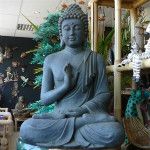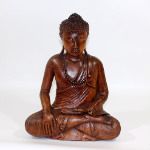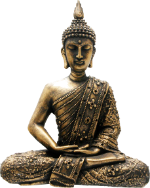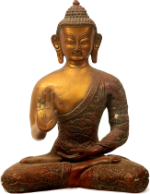Post by angelscandle on Feb 19, 2010 16:03:30 GMT
Mudras are symbolic gestures, used symbolically in Buddha images and in practice to evoke particular ideas or buddhas in the mind during Buddhist meditation or ritual.
Like symbols held by saints in Christian art or by gods in Hindu art, Buddhist mudras indicate the identity of a Buddha or a particular scene being depicted.
Mudras are also used in ritual meditation, especially in Tibetan Buddhism, to generate forces that invoke a particular Buddha or deity.
While there are a large number of esoteric mudras, there are ten main ones, of which five are most commonly used in Buddha images. Each of the Five Dhyani Buddhas is assigned one of the five mudras, with which they are invariably depicted in art.
Follow a link below to learn more about each of the five main mudras and see examples of Buddha images featuring those mudras.
 Abhaya Mudra (Fearlessness)
Abhaya Mudra (Fearlessness)
The gesture of fearlessness and protection, representing spiritual power. This mudra is most often seen in standing Buddhas.
 Bhumisparsha Mudra (Earth Witness)The gesture of "earth witness," which the Buddha is said to have made at the time of his Enlightenment.
Bhumisparsha Mudra (Earth Witness)The gesture of "earth witness," which the Buddha is said to have made at the time of his Enlightenment.
 Dharmachakra Mudra (Wheel Turning)The gesture of "wheel-turning" or the turning of the wheel of the dharma, representing the Buddha's teachings.
Dharmachakra Mudra (Wheel Turning)The gesture of "wheel-turning" or the turning of the wheel of the dharma, representing the Buddha's teachings.
 Dhyana Mudra (Meditation)
Dhyana Mudra (Meditation)
The gesture of meditation.
 Varada Mudra (Gift Giving)
Varada Mudra (Gift Giving)
The gesture of gift-giving or bestowal.
Sources
1.Mudras: Sacred Hand Gestures - BuddhaNet 2.Buddhist Art and Architecture: Hand Mudras - BuddhaNet
3.The Ten Most Important Mudras - Neurotopia
4.Buddhist Hand Gestures - Government of Tibet in Exile
5.Mudras: Hand Positions of the Buddha - Lotus Sculpture
Like symbols held by saints in Christian art or by gods in Hindu art, Buddhist mudras indicate the identity of a Buddha or a particular scene being depicted.
Mudras are also used in ritual meditation, especially in Tibetan Buddhism, to generate forces that invoke a particular Buddha or deity.
While there are a large number of esoteric mudras, there are ten main ones, of which five are most commonly used in Buddha images. Each of the Five Dhyani Buddhas is assigned one of the five mudras, with which they are invariably depicted in art.
Follow a link below to learn more about each of the five main mudras and see examples of Buddha images featuring those mudras.

The gesture of fearlessness and protection, representing spiritual power. This mudra is most often seen in standing Buddhas.



The gesture of meditation.

The gesture of gift-giving or bestowal.
Sources
1.Mudras: Sacred Hand Gestures - BuddhaNet 2.Buddhist Art and Architecture: Hand Mudras - BuddhaNet
3.The Ten Most Important Mudras - Neurotopia
4.Buddhist Hand Gestures - Government of Tibet in Exile
5.Mudras: Hand Positions of the Buddha - Lotus Sculpture






